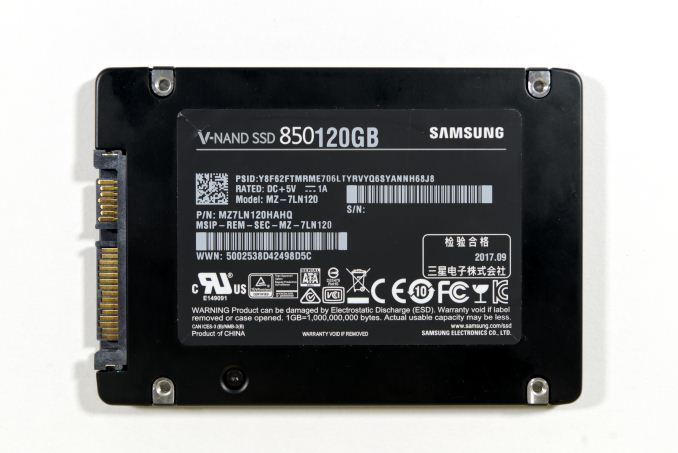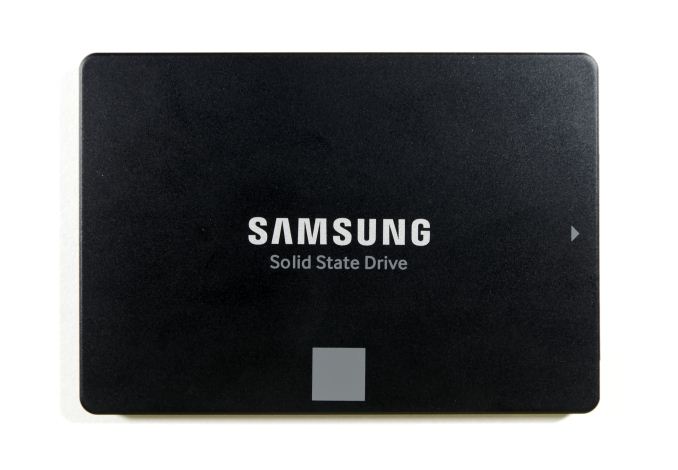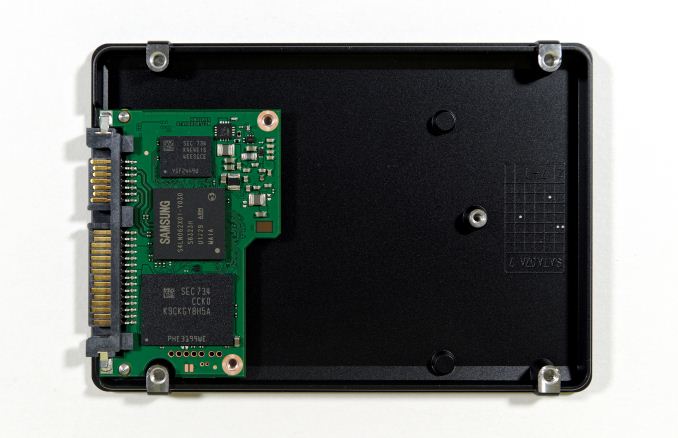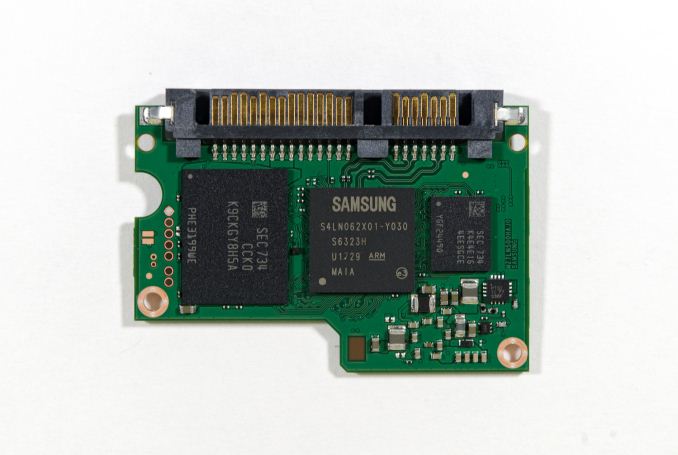The Samsung SSD 850 120GB Review: A Little TLC for SATA
by Billy Tallis on November 27, 2017 12:00 PM EST
The latest entry level SSD from Samsung has no suffix and bears neither the PRO or EVO appellation. It is a new entry-level SATA SSD featuring Samsung's latest 64-layer 3D TLC NAND, making it a very close relative to the 850 EVO line.
The Samsung SSD 850 120GB Review: A Little TLC for SATA
The SSD 850 120GB uses the same MGX controller as the 850 EVO, but with a newer generation of 3D NAND. The drive is intended to fill a gap that has existed in Samsung's retail product line since the 750 EVO was discontinued a little over a year ago, as it left Samsung with no 120GB-class retail SSD. So far, the SSD 850 120GB has only been officially released by Samsung's Chinese division, but it is available in other Asian markets including from some online retailers that will ship to us in North America. The release it seems will be staggered across regions.
The Samsung 750 EVO was a stopgap product, using 16nm planar TLC, while the 850 family transitioned from 32-layer to 48-layer 3D NAND. That transition for the 850 series doubled the capacity per die, from 128Gb to 256Gb. With half as many dies to use in parallel, the smallest capacities of the 850 PRO and EVO would no longer meet the same performance specifications. Changing components like this without renaming the product can be controversial, but Samsung took the reasonable route of discontinuing the 128GB 850 PRO and 120GB 850 EVO. It was their hope that the 120GB capacity class would be rendered mostly obsolete by the price/GB improvements enabled by denser 3D NAND.
When Samsung's 48L 3D NAND initially failed to reach its production or price targets, it became clear that Samsung still needed an affordable 120GB-class drive in its retail lineup. The 750 EVO was introduced to fill that gap, using 16nm TLC but retaining the same top-notch SSD controller from the 850 series. The 750 EVO initially debuted with 120GB and 250GB capacities, but a 500GB version was added as SSD prices began to rise across the industry due to a global shortage of NAND flash memory. (The disappointments of Samsung's 48L 3D NAND were one of the major supply-side factors leading to the shortage, but insatiable demand for SSDs and the difficulties everyone else had bringing any kind of 3D NAND to market were also very important contributors.) By the end of 2016, SSD prices were still rising but Samsung quietly discontinued the 750 EVO, again leaving them with a gap at the smallest end of the capacity range.
The Samsung SSD 850 120GB is a product that Samsung never wanted to release, and it may even never see a global release. The fundamental challenge of offering 850 EVO-class performance on a drive with just four NAND flash dies hasn't gone away. Samsung's 64L 3D NAND is claimed to be a bit faster than the 48L NAND for writes, and power consumption is supposed to be lower for both reads and writes. This won't do much to offset the effects of limited parallelism with only four NAND dies.
| Samsung TLC SATA SSD Comparison | |||||
| Drive | 850 120GB | 750 EVO 120GB | 850 EVO 120GB | ||
| Launch | China: Nov 2017 | April 2016 | December 2014 | ||
| Controller | Samsung MGX | Samsung MGX | Samsung MGX | ||
| NAND | Samsung 256Gb 64L TLC V-NAND | Samsung 128Gb 16nm TLC | Samsung 128Gb 32L TLC V-NAND | ||
| DRAM | 256 MB | 256 MB | 256 MB | ||
| Sequential Read | 540 MB/s | 540 MB/s | 540 MB/s | ||
| Sequential Write | 520 MB/s | 520 MB/s | 520 MB/s | ||
| 4KB Random Read | 70k IOPS | 94k IOPS | 94k IOPS | ||
| 4KB Random Write | 88k IOPS | 88k IOPS | 88k IOPS | ||
| 4KB Random Read QD1 | 10k IOPS | 10k IOPS | 10k IOPS | ||
| 4KB Random Write QD1 | 40k IOPS | 35k IOPS | 40k IOPS | ||
| Encryption | AES-256, TCG Opal 2.0, IEEE-1667 (eDrive) | AES-256, TCG Opal 2.0, IEEE-1667 (eDrive) | AES-256, TCG Opal 2.0, IEEE-1667 (eDrive) | ||
| Endurance | 75TB or 100TB | 35TB | 75TB | ||
| Warranty | Three years | Three years | Five years | ||
Like the 750 EVO, the Samsung SSD 850 120GB inherits all the 850 EVO's features like TCG Opal support thanks to using the same controller, but the 850 120GB's three year warranty is shorter than the five years on the 850 EVOs. The write endurance is thankfully on par with or better than the old 120GB 850 EVO (Samsung China's site is inconsistent about this specification), whereas the 750 EVO had less than half the write endurance. The only performance specification where the 850 120GB is slower than the old 850 EVO 120GB is for random reads at QD32, where it has lost 25% of the peak performance. However, performance numbers on the box like these do not tell the whole story.
A Lot of Empty Space
The Samsung S4LN062X01 "MGX" controller in the 850 120GB is old news. After three years on the market in the 850 EVO and related OEM and enterprise SSDs, it's still one of the top SATA SSD controllers with all the expected features and great performance and power management.
While the 750 EVO put the controller and DRAM in the same BGA package, the 850 uses the original controller packaging with the DRAM next to it on the circuit board. The Samsung SSD 850 120GB uses the same PCB as current 850 EVOs up to 500GB, with one of the two NAND package spots populated, and the case is Samsung's standard matte black metal secured with three pentalobe screws.
Samsung's NAND flash part numbers don't directly encode the manufacturing process used. The sole NAND package on the 850 120GB is marked K9CKGY8H5A. The "CKG" portion identifies this as a TLC package with four dies and a total capacity of 128GB, implying the use of 256Gb (32GB) dies. The "A" at the end of the part number designates this as Samsung's second generation of 256Gb TLC parts. The first generation of 256Gb TLC dies from Samsung was manufactured with their 48-layer V-NAND process, making this new part their 64-layer design. When Samsung gets around to shipping their 512Gb 64L TLC dies, they'll be marked with a "M" at the end of the part number because they are Samsung's first generation 512Gb TLC parts.
This isn't our first encounter with Samsung's 64-layer fourth-generation 3D NAND. The Samsung Portable SSD T5 launched earlier this year as the first product to feature the 64L TLC V-NAND. Samsung used a portable SSD as the trial run for their preceding 48-layer 3D NAND as well, followed by a gradual migration of the rest of the product line. Samsung hasn't stated whether they plan to migrate the 850 EVO line over to 64L TLC in the same manner as they transitioned it from 32L to 48L, but I suspect they will. SATA SSDs aren't going away any time soon, and the current 850 EVOs are already competitive with the 64L 3D TLC SSDs from Western Digital/SanDisk and Intel. Updating the 850 EVO with 64L 3D TLC won't hurt the small capacity models because the capacity per die remains 256Gb.
The future of the 850 PRO line and MLC drives in general is less clear. Samsung has said nothing about 64L MLC and even their enterprise SSDs are all on TLC now (except for the Z-NAND based SZ985). The 850 PRO has very little reason to continue existing now that NVMe drives are the high-performance option, so Samsung may end up discontinuing it and simplifying their retail SATA line to just a range of TLC-based 850s, starting with this 120GB model. In the NVMe space they will probably keep a MLC model around for enthusiasts unless their next generation of TLC-based NVMe SSDs can deliver huge performance increases. We expect Samsung to officially disclose some of their plans early next year, either at CES or shortly thereafter.
There isn't much competition in the 120GB capacity class of SSDs. Other manufacturers have also largely abandoned this segment as they transition to 3D NAND with per-die capacities of 256Gb and larger. The only recent SSDs we have to compare against are a few drives using Micron's 384Gb 32L 3D TLC NAND. The first two, the ADATA Ultimate SU800 and the HP S700 Pro, pair that Micron NAND with the Silicon Motion SM2258 controller, while the other member of the set is the HP S700, which adopts the DRAMless SM2258XT controller. The rest of the 120GB-class drives we have tested are all discontinued: the Samsung 850 PRO 128GB, the Samsung 850 EVO 120GB, the Samsung 750 EVO 120GB, the ADATA SP550 using planar TLC, the PNY CS1311 also using planar TLC, and the ADATA XPG SX930 which uses planar MLC and a JMicron controller.
The glaring omission from this review is the Crucial BX300. Micron used their 3D MLC for this model specifically designed to perform well at low capacities, but then they only sampled us the largest size to test. The 120GB BX300 is currently priced very well for a 120GB drive even before taking into account that it uses 3D MLC instead of TLC. It's also readily available for purchase in most markets. Based on the results at higher capacities, we expect the 120GB BX300 to be slightly below
| AnandTech 2017 SSD Testbed | |
| CPU | Intel Xeon E3 1240 v5 |
| Motherboard | ASRock Fatal1ty E3V5 Performance Gaming/OC |
| Chipset | Intel C232 |
| Memory | 4x 8GB G.SKILL Ripjaws DDR4-2400 CL15 |
| Graphics | AMD Radeon HD 5450, 1920x1200@60Hz |
| Software | Windows 10 x64, version 1703 |
| Linux kernel version 4.12, fio version 2.21 | |
- Thanks to Intel for the Xeon E3 1240 v5 CPU
- Thanks to ASRock for the E3V5 Performance Gaming/OC
- Thanks to G.SKILL for the Ripjaws DDR4-2400 RAM
- Thanks to Corsair for the RM750 power supply, Carbide 200R case, and Hydro H60 CPU cooler
Not all of our regular benchmarks are performed in this review to begin with. Our test called 'The Destroyer' is slightly delayed - on the first run through, the SSD 850 returned suspiciously low scores, so it is currently being re-run. ATSB on the 2017 testbed for a few other 120GB drives were also not at hand due the drives being in service as boot drives on other testing machines. The page of results for The Destroyer will be added later today (11/27).



















31 Comments
View All Comments
Kristian Vättö - Monday, November 27, 2017 - link
There are still MLC based enterprise SSDs from Samsung, such as SM863a.yifu - Saturday, December 2, 2017 - link
also Toshiba hk4rqlum - Monday, November 27, 2017 - link
For the pc's at work I always use 120gb ssd's as they offer enough capacity and are still about €20 cheaper then 200gb+ drives.bug77 - Tuesday, November 28, 2017 - link
I'm not sure giving up 80GB (40%) space to save €20 is the right choice. Remember, these things don't like being full and people tend to save a lot of junk of their drives.That said, the smallest SSD is still way better than the fastest HDD. (Have you ever seen Win10 trying to patch itself while installed on a HDD?)
ads295 - Tuesday, November 28, 2017 - link
I think that's why laptops started skipping on the HDD activity LED from as early as when Win8 was available.bcronce - Tuesday, November 28, 2017 - link
Great for my firewall. I only need ~4GiB of space.Glaurung - Tuesday, November 28, 2017 - link
"Remember, these things don't like being full and people tend to save a lot of junk of their drives."For situations where the drive is never going to be full and you just need the cheapest possible SSD, it's fine. For instance, My spouse writes reports for a living, and she has never come anywhere near to filling up the 40gb X25-V on her work laptop. (no music, no pictures, no videos, just documents and PDFs and audio recordings that she refers to and then deletes when the report gets final client approval).
pixelstuff - Monday, November 27, 2017 - link
We've been missing the 128GB 850 Pro model with it's 10 year warranty, which usually cost about $90. We were using it in single task devices such as DVRs with secondary data drives. Having to move to the 256GB 850 Pro just meant we had to spend an extra $30+ for no extra benefit, and unfortunately those 256GB drives never dropped to the $90 price range.mapesdhs - Wednesday, November 29, 2017 - link
Pricing did drop that low at one point; in the UK the 850 EVO 250GB was 53 UKP from Amazon and not much more elsewhere (meanwhile, 500GB pricing was slowly heading down to 100 UKP), but then after a blowout sale of several thousand 850 EVO 500GB units by one retailer in two weeks at around 115 UKP each (I bought two), I'm sure Samsung realised they simply didn't need to sell their tech so cheap, prices went up, and all the other vendors followed suit. Also, when new models came out, old models were almost immediately removed from seller sites, sometimes on the same day. Since then, pricing has almost doubled, there's just no need for the manufacturers to offer low pricing when they can easily sell everything they make due to OEM demand. It's ironic that the nature of that demand is largely by a consumer demographic that treats tech as thoroughly disposable, and often has little regard for what it is or how it works.The more I see new products like this being worse than old products, the more I'm impressed with what Intel has done with Optane, etc. At least Intel has actually done something new, whereas Samsung seems to have done what Intel did with its CPU-based strong position, ie. sat on its butt for several years while the cash rolled in and not bothered to innovate. Have to wonder why Samsung couldn't have brought ought something like Optane ages ago, and for the consumer market, not just Enterprise. Yes there's a shift towards NVMe, but it's not that big yet (with warranties 50% shorter and insane price hikes on retail versions), and a lot of consumers just want capacity with decent quality. At this point a 4TB SATA SSD with the quality level of the 850 EVO would sell very well if sensibly priced, but nobody's even trying, they're still having fun selling low capacity models (why sell one 4TB when one can make a lot more selling twenty 120GB units). I remember SanDisk promised to have an 8TB model by now, but that never happened.
Billy, add the old 840 and 840 Pro into those results charts, I bet this new 850 wouldn't look so impressive, ditto if other old models were included too like the Vertex 4, Vector, Neutron GTX, etc. Heck, even the old 830 would likely put most of the modern non-Samsung models to shame (ditto something as ancient as a Vertex3, and it'd be hillarious too see where the budget Agility3/4 would fit in the charts today). SATA SSDs have become like CPUs before Ryzen finally launched, the tech has stagnated or even gone backwards. The 750 was touted as a cheaper 850 EVO, but in reality it became more expensive. I get that the nature of parallelism in NAND means larger dies don't offer the performance at lower capacities, but then that's why it would make sense to create something genuinely new; Intel needed a good poke in the ribs from Ryzen to get moving again with its CPU line, but at least it *did* something with respect to developing new storage tech.
Ian.
WithoutWeakness - Monday, November 27, 2017 - link
First section header in the introduction: The *Samung* SSD 850"